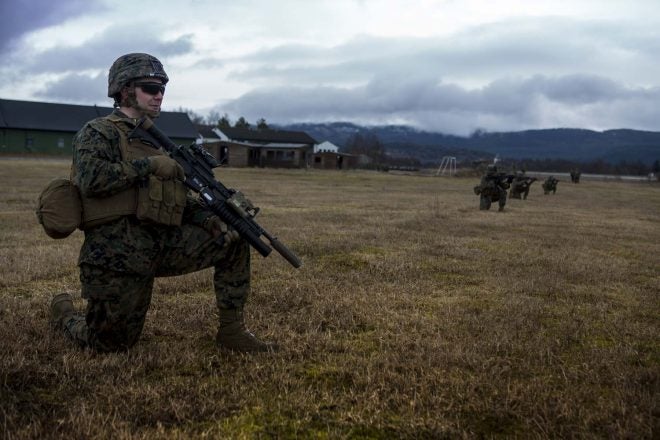Gentlemen, it has begun: The Silencing is upon us.
Following a series of trials testing the feasibility of an infantry battalion equipped entirely with suppressors, the United States Marine Corps has moved quickly to field the first all-suppressed unit to the Værnes Air Station garrison in Stjørdal, Norway. This deployment, and more importantly its overwhelmingly positive reception, appear to signal the beginning of the end for unsuppressed infantry weapons in the West. From Military.com:
VAERNES GARRISON, Norway — When Bravo Company, 1st Battalion, 2nd Marines, arrived here in January, they weren’t just beginning a brand-new rotational deployment. They were also the first Marine Corps infantry unit to deploy with suppressors on every individual service weapon.
And three months into using suppressed weapons in every exercise and live-fire training event, Marines who spoke with Military.com say they never want to go back.
In November, Military.com broke the news that the Corps was embarking on a proof-of-concept effort to silence every weapon in an infantry battalion, from M4 service rifles to .50 caliber machine guns.
In an interview at the time, 2nd Marine Division commanding officer Maj. Gen. John Love said the suppressors, also called silencers, were already changing the way Marines operated in early testing and evaluation.
“It used to be a squad would be dispersed out over maybe 100 yards, so the squad leader couldn’t really communicate with the members at the far end because of all the noise of the weapons,” he said. “Now they can actually just communicate, and be able to command and control, and effectively direct those fires.”
Troops with Marine Corps Rotational Force-Europe agree.
They’ve used suppressed M4s and M27 infantry automatic rifles in Arctic cold-weather training environments and most recently at a joint live-fire attack event in Romania. During that event, three platoons from Bravo Company operated alongside one from the battalion’s Weapons Company that didn’t have suppressed rifles. The difference was marked, said Capt. Mark Edgar, commanding officer of Bravo Company.
“It took us back to remembering what it was like not to be suppressed, when you see people trying to communicate,” Edgar said. “For guys in charge of other Marines, being able to talk is a big way that we fight. The suppressed weapons have helped that a lot.”
For Staff Sgt. Troy Hauck, a platoon sergeant with Bravo Company’s Weapons Platoon, not having to worry about ear protection when firing his rifle is a nice bonus. But a potentially bigger boon is the element of surprise that comes with a suppressed weapon.
“Just doing some of the training attacks that we’ve done on this deployment has been good,” he said. “I’m on one side of the hill and [part of the company is] on the other side of the hill, and I can’t hear them firing their weapons. It’s pretty nice, real stealthy.”
I highly recommend clicking through and reading the full article over at Military.com.
I don’t often throw out predictions, because the simple fact is that I know I can’t do so with confidence most of the time. However, in this instance I think I can make an exception: This is the beginning of the end for unsuppressed issue infantry weapons in the Western world. I expect in 10-15 years for it to be a requirement taken entirely for granted that infantry weapons must be capable of operating suppressed all the time.
Existing suppressors (such as the KAC NT4s used in the test) do still face some hurdles before the cans of war can be loosed upon the world, however. In the article, Staff Sgt. Nelson Acevedo identified four problems that suppressors introduce: They get very hot, they have to be cleaned properly, they add weight, and they can occasionally come loose from the muzzle. All of these issues will delay the issuance of suppressors as standard military kit, but none are likely to prevent it altogether. The communication and stealth improvements offered by suppressors have now been proven to make a qualitative difference in small unit operations, and it is unlikely that these advantages will be simply left on the table moving forward.
 Your Privacy Choices
Your Privacy Choices
